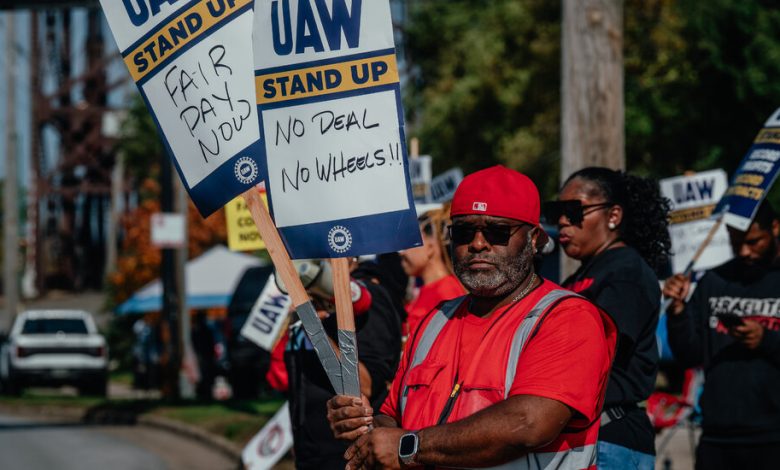U.A.W. and Ford Negotiators Reach Accord on Contract Terms

Negotiators for the United Automobile Workers and Ford Motor have agreed on terms of a new four-year labor contract, people close to the negotiations said Wednesday, nearly six weeks after the union began a growing wave of walkouts against the three Detroit automakers.
The deal includes a roughly 25 percent pay increase over four years, those people said. Any agreement would be subject to the approval of the U.A.W. council that oversees relations with Ford, and then ratification by the company’s union workers.
The union continues to negotiate with General Motors and Stellantis, whose brands include Chrysler, Jeep and Ram.
Two weeks ago — when it said it had reached the limit of what it could afford without hurting its business — Ford offered to increase wages 23 percent, adjust pay in response to inflation and cut the time for new hires to rise to the top wage, to four years from eight. The other companies have made similar offers.
But the U.A.W. and its president, Shawn Fain, have pressed for greater concessions, ratcheting up the walkouts and aiming them at factories producing some of the automakers’ most profitable models.
Altogether, about 45,000 workers at Ford, G.M. and Stellantis are on strike across the country, including 8,700 workers at Ford’s Kentucky truck plant in Louisville, the company’s largest, and almost 10,000 others at Ford factories in Illinois and Michigan.
The tentative deal with Ford could increase pressure on the other companies to reach an agreement with the union. In the past, once the union reached a deal with one automaker, tentative agreements with the others quickly followed. But that history may not be as relevant now because the U.A.W. had never struck all three companies simultaneously until this year.
The companies are investing billions in a transition to battery-powered vehicles, which they say makes it harder for them to pay substantially higher wages. Last week, Ford’s executive chairman, William C. Ford Jr., said the union’s demands risked damaging the ability of Detroit automakers to compete against nonunion companies like Tesla and foreign rivals.
“Toyota, Honda, Tesla and the others are loving the strike, because they know the longer it goes on, the better it is for them,” he said. “They will win, and all of us will lose.”
The U.A.W. makes a different case: that success in its contract battle with the Big Three will give it momentum to organize autoworkers at other companies as well.
The U.A.W. began its walkouts when the companies’ union contracts expired in mid-September. It won immediate support from President Biden, who called on the automakers to “ensure record corporate profits mean record contracts” and briefly joined workers on a picket line at a G.M. plant near Detroit late last month.
The union initially demanded a 40 percent wage increase over four years — an amount that union officials have said matches the raises the top executives at the three companies have received over the last four years. Those raises are also meant to compensate for more modest increases the autoworkers received in recent years and concessions the union made to the companies beginning in 2007.
In addition, the union has called for an end to a system that pays new hires just over half of the top wage of $32 an hour. It has been seeking cost-of-living adjustments that would nudge wages higher to compensate for inflation. And it wants a reinstatement of pensions for all workers, improved retiree benefits and shorter work hours.
G.M. and Stellantis faced the most recent escalation of the U.A.W. walkouts when the union called out 6,800 workers at a large Ram pickup truck plant in Michigan on Monday and 5,000 workers at a G.M. plant in Arlington, Texas, that makes large sport utility vehicles including the Chevrolet Tahoe, the GMC Yukon and the Cadillac Escalade.
On Tuesday, G.M. reported a third-quarter profit of $3.1 billion, a 7 percent decline from the same period last year, owing in part to the ongoing strike. Ford is scheduled to announce its third-quarter earnings on Thursday.
